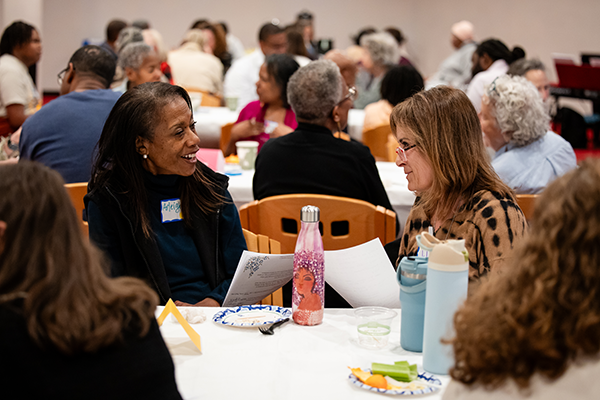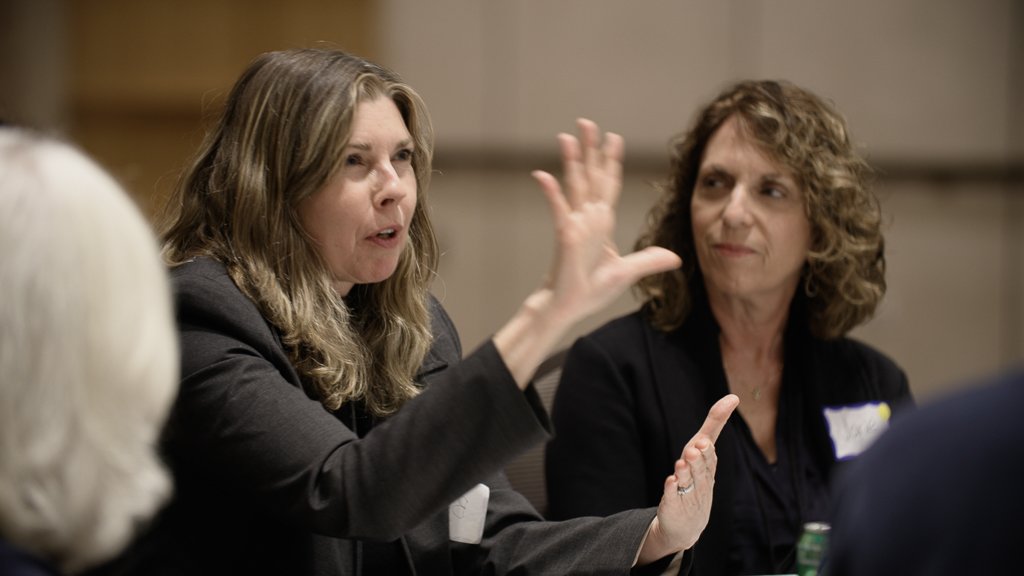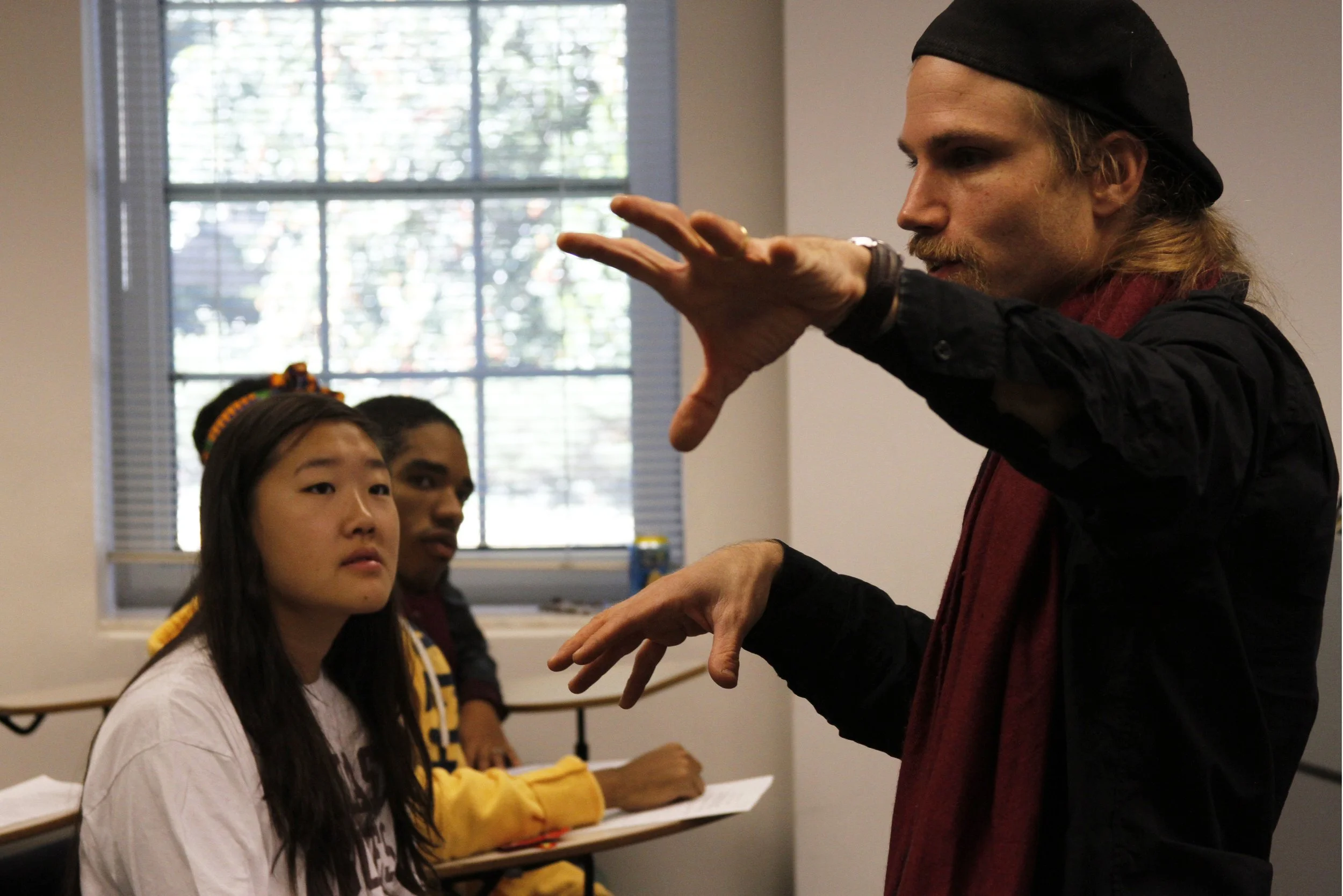
Processes & Residencies to Strengthen Connection & Collaboration Across Differences
ASC provides both stand-alone cohesion processes and residencies.
• Each cohesion process creates a threshold for connection—and helps people cross it in ways that feel safe, easy, and even more alive.
• Residencies typically consist of: Different Ships, Same Boat & 2 or more processes from the list below & an optional pedagogical breakout & an optional residency culmination.
Residency Duration: Residencies can fit two intensive days or spread out over several weeks.
Geographies Served: Flexible. ASC is built to travel nimbly and lightly, drawing on decades of intensive domestic and international touring. Please contact ASC to discuss your needs
Residencies generally begin with Different Ships, Same Boat to cultivate motivation to participate, trust and establish a values sphere setting the residency’s tone
ASC Cohesion Processes Include:
-

Crowdsourced Poems with Original Score: Mirroring What’s Shared, What’s Unseen
A crowdsourced poem is made from community members' reflections and words.
• Community members write responses to prompts, tailored according to relationships developed over site visits.
• Those responses shape a spoken word poem reflecting the community's feelings, beliefs, values, inspirations, trepidations and aspirations.
• Anonymous participation encourages candor.
• The poem is scored with original music and shared back live with the community.
• The poem is like a survey, revealing both what’s in common as well as unspoken tensions and disagreements within the group.
_______
“Regie sings and chants for all of us. Nobody gets left out.”
— Kurt Vonnegut"...a vital and vibrant way to illustrate the possibilities of interfaith and intercultural cooperation"
— Greg Mcgonigle, Tufts University, Medford, MA -

Ponder to Page: Small Stories, Unexpected Connections
Ponder to Page deepens and accelerates connection through a fun, easy, safe three-step process for crafting resonant stories out of seemingly small, meaningful experiences — even those that may seem quite ordinary.
• Designed especially for "non-writers:” Brief writing “experiments” (90 seconds!) and deft pedagogy transform story crafting from “scary” to “exciting” and easily doable — for anyone.
• Participants ease into depth with their own experience, those of fellow participants, and the resulting bonding with people who, at first, are often strangers. Looking back, participants cannot pinpoint a “big-deal plunge.” The relational deepening occurs degree by degree, nearly imperceptibly.
• Ponder to Page crafts the conditions for participants to listen generously, and share, real-life stories from increasing depth. Being moved by each others' stories shifts participants’ unspoken inferences about themselves, each other and social situations. The workshop's environment helps these shifted narratives self-reinforce towards long-lasting changes.
• The workshop also offers proven story skills useful in many situations —personal, community-based & professional (e.g. both Regie and Guy's children recently used these skills on college/high school applications, resulting in acceptance and scholarship)
_______
“An unimaginable affirmation of all it can mean to strengthen, deepen, and encourage community connection through the prism of the Arts. To foster connection by helping members see beyond themselves, Recognizing that their needs, hopes, hurts, dreams are shared. And, therefore, to open people up to one another, enabling them to see in someone else's story a thread of their own.”
— Jeffrey Sirkman, Senior Rabbi, Larchmont Temple, Larchmont, NY
“Ponder to Page brought creativity, vulnerability, and connection to the Adams Theater — and welcomed enthusiastic first-time visitors through our doors. Guy and Regie led with remarkable professionalism, care, and an intuitive gift for engagement that drew everyone in.”
— Yina Moore, Founder & Artistic Director, The Adams Theatre
-

Listening Labs: Tools & Artistry for Connection
Even after the 2024 elections, and amidst intensifying fragmentation, some 70% of Americans — across party lines — feel they have a sense of responsibility to connect with people whose ethnic, political, religious and economic backgrounds and viewpoints are different from their own(1). The most common reason people give for seeking such “bridging” is to improve their communities. Among the most reliable reasons people do not do this is anxiety about engaging with others across these lines of difference. One promising strategy to reduce this anxiety is high-quality listening.
Americans tend to know this. Some 80% - across party lines - think they are good listeners. Yet 66% also feel that others do not listen well. On average, approximately 50% of Americans — and 68% of Gen Z — express interest in further cultivating high-quality listening skills (2).
• The Listening Lab draws on the science of connection but is more than academic: The Lab is a place of action, where participants test tools by doing, and gather data through experience.
• Through a series of small, often playful, and safe experiments, participants explore ways to listen, models of conversation, techniques to cool the heat that often leads to interruption, initiate conversations that bypass surface chitchat, tell moving stories, offer feedback that encourages more connection, and maintain psychological safety and a realness that leaves people feeling alive to each other and themselves.
• ASC’s moving stories — told through powerful spoken word, music, and theatrically projected sand animation — facilitate generous listening with fellow participants in conversations that are honest, intimate, and alive.
_______
“…a brilliant way to ensure that more voices are heard and different perspectives are recognized. And it's not the same perspective and voice as people expect, not a rehash. It's really fresh.”— Anne Lee, Board President and Executive Director, Lexington Historical Society, Lexington MA
(1). More In Common March 2025 national study of over 6,000 US adults across political, religious, economic and ethnic spectra.
(2). More in Common June 2025 national study of over 2,000 US adults across spectra
-

Ten Toasts Dinners: Laughter, Realness, Connection
Participants join each other for a dinner as we regale each other with meaningful conversation and stories in the form of toasts reflecting a theme tailored to the group, (e.g., “To Those Who Shape Us.*”)
It’s like a game: Participants dine in groups of 8-12 fellow travelers (hopefully whom they do not know or know well). At some point in the dinner, each participant is invited to ding their glass and share a brief story or experience that ideally no one at the table has heard before, relating to the theme: For example, a story about a person that shaped the teller, and about a way the teller was changed. At the end of their story, the teller raises their glass and toasts to an element or value their story highlights (e.g., to those who taught us resilience!) and invites all others in their group to raise their glasses as well.
What motivates people in a fun, safe way? The only other rule: The last person in each group has to sing their toast!
Ten Toasts Dinners are built for genuine engagement, quickly bypassing surface chitchat into a space of realness.
(*Note: this theme is a sample. Actual themes reflect specific groups)
This is an artistic ASC adaptation of a gathering structure learned from Priya Parker, and includes live performance.
_______
“My husband is an introvert. And before the [ten toasts] dinner he was saying things like ‘Oh my God, I can't do this. I don't have a story. I don't know what to do.’ But you know what happened? Because ASC set it up just right, everybody was popcorning stories. And [he] jumped in, even before I did, because he got in the flow. It felt so organic. He felt welcomed, and he told us the greatest story. One that I had not known!
To me, that is the highest possible praise: my husband, who was nervous as hell to be there, opened up and participated. It was because the facilitation was so beautiful, it wasn't scary or alienating the way Regie showed us how to do it — and did it himself. He set the tone, we had a table leader, and we all just popcorned. That's the magic of great facilitation...”— Participant & Cultural Leader, Boston, MA
Residencies may also include:
-

Optional Pedagogical Breakout
This interactive workshop is geared for folks who want to design situations that increase connection and collaboration. Drawing on participants’ direct residency experience, the workshop reverse engineers ASC’s cohesion processes to highlight underlying principles that folks can use in many areas of their own lives, personal or professional.
The workshop then explores ways these principles can be actualized. Written materials and a reading list are provided.
This pedagogical breakout is not a facilitator training, which requires a much greater investment of time and practice. Rather, it offers perspectives and principles that can immediately inform participants’ plans for social situations.
No prior cohesion, facilitation or artistic experience is required. Description goes here
___________• Duration (excluding setup): 1 - 2 hrs
• Group Size: Flexible, please contact ASC to discuss your needs• Team: 2 ASC facilitators + 1-3 support staff depending on group size
-

Optional Residency Culmination
This takes various forms, ranging in production complexity.
Examples include:• Performances in which participant’s stories (from Ponder to Page workshop) are set to original music and professionally performed
• Books and audio archives of group members' stories
• Full-on multimedia productions in which real-world stories, told by the community members who've lived them are filmed and theatrically projected together with live original narration, cinematographic score & musical segments designed & performed by ASC’s world class artistic team
___________
Production time, setup & team: Varies depending on complexity. Please contact ASC to discuss your vision.
